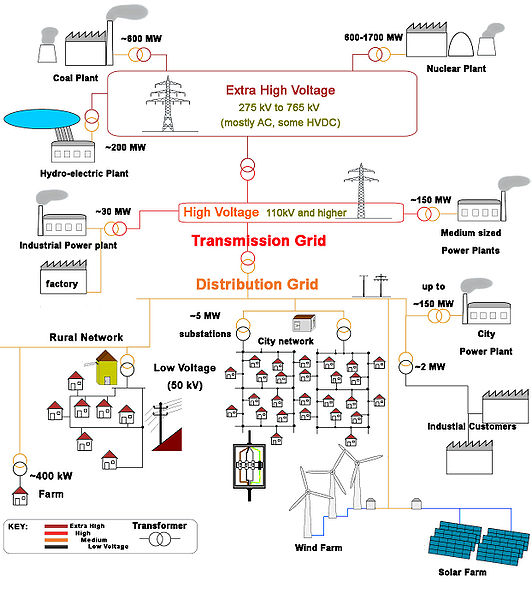Scotty! We Need More Power!
 Saturday, October 17, 2009 at 3:53PM
Saturday, October 17, 2009 at 3:53PM  MAD21
MAD21 By Alan
I was asked the other day what "The Smart Grid" was, and what it was going to do, and I had to pause a bit, because the term means different things to different people. Predictions about what it will mean are even more difficult, if not impossible. In fact, in order to know more about what's going to happen in the future, we need to understand what's there now. So, we'll do this in two parts. What we have, and what we'll be getting.
First, let's explain a little bit about the Electricity Grid in the United States.
Demand and Supply?
Unlike nearly all other products, electricity must be instantly generated as soon as it is consumed. Notice the order of importance there. Production has to keep up with consumers, not the other way around. Nearly everything else that we produce and consume is opposite: Someone creates the product, and develops inventory, and the consumer buys what's available. In the current electrical market, consumers just consume, and everything else is geared towards keeping up with that demand. Blackouts, brownouts, and sudden soaring prices are all directly related to unexpected difference between demand and supply.
One Grid?
The United States is not a single power grid. There are three major grids, East, West, and Texas. These may or may not get connected in the future. But, each of those grids are broken up into smaller chunks, and those chunks are broken up into smaller chunks (named different things for different areas: Regions, Zones, sub-zones, operating areas, and others).

NPR has an even better Flash map showing different aspects of the grid.
Who controls it?
The Federal Energy Regulatory Commission (FERC) is charged with helping consumers get affordable electricity, usually by regulating the market around electricity, but it does not own it. In fact, it doesn't even directly control it.
Contrary to popular misconceptions, no part of the US Grid is controlled by the government (though some municipal districts own their particular power plants and wires), nor is it solely controlled by any power company. Depending on which part of the country you live in, the "Grid Authority" is an independent entity that regulates the competing utilities, often by cooperation, dollars, and incentives rather than completely by laws and regulations.
Okay, then who operates it?
To quote FERC:
Electricity is generated as it is used. There is very little ability to store electricity. Because of this instantaneous nature, the electric power system must constantly be adjusted to ensure that the generation of power matches the consumption of power. On continental U.S. power grids, roughly 150 Control Area Operators serve this function by using computerized control centers to dispatch generators as needed.
What is the Grid made of?
The grid is primarily made up of 3 components, Generation, Transmission, and Distribution.

Generation deals with any method of creating electricity, be it Coal, Natural Gas, Nuclear, Geothermal, Wind, Ocean Wave energy, Biomass, Hydro, or lots of lesser used methodologies.
Transmission  deals with the long distance connections of electricity from the generation source to the distribution grid. High tension wires and long distance transmission is a completely different engineering science than neighborhood power lines. Extra High Voltage Transmission lines can take power hundreds of miles before losing too much in the cabling to make it worthwhile.
deals with the long distance connections of electricity from the generation source to the distribution grid. High tension wires and long distance transmission is a completely different engineering science than neighborhood power lines. Extra High Voltage Transmission lines can take power hundreds of miles before losing too much in the cabling to make it worthwhile.
Distribution deals with the concept of putting power into individual homes, businesses and factories. Usually, this means taking power from high-voltage transmission lines and converting it to lower voltage AC power for use in the home. This is the traditional role of the Utility Company.
Storage Notice what is NOT part of the grid diagram. You don't see batteries. Believe it or not, you can't store large amounts of electricity for any length of time at all. Many ideas about Grid Storage exist, but each has limitations. Giant flywheels are smooth power savers, and can help small parts of the grid for a few seconds. For long term storage, the most efficient large scale storage is actually when hydroelectric plants that pump water uphill when electricity is cheap, and let it flow downhill generating power when needed.
Future plans include plugging electric vehicles into the power grid for distributed storage. More on that in a future article about “What is The Smart Grid”?
Also notice that power transmission still requires wires. Although wireless is being explored it won't be implemented anywhere soon.
Why have Operators?
Normal consumer electrical power in the United States runs at 60Hz 120V AC. (Translation: 120 Volts of Current alternating at 60 times a second). Each of these components is very important.
Everyone knows that plugging in a 120 Volt device into a dryer plug that is 240 volt will result in sparks, smoke, fire and/or death. But that 60Hz is also extremely important. Tiny variations in that value (less than 1%) would cause havoc across the country. Motors would burn up, power lines would be stressed, and even some clocks would run too slow or too fast.
All generators in a particular portion of the grid need to run at exactly the same frequency, and delivery the alternating current at exactly the same time. So, this means that entire portions of the country need to have highly precisely timed and coordinated generators in order to participate in the electrical grid. It's not possible to just fire up a generator, and connect it to the power lines. It has to be synchronized.
Remember that the Grid runs based on the principle that consumers turn on things that need power, and the generators need to respond to provide power for that need. If generators don't keep up instantly, then the power voltage will dip, and the frequency will become unstable. If the generators respond quick enough, then the impact would only result in a brownout. But, if they don't respond fast enough, it will threaten the generator, and cause circuit breakers to trip, causing a blackout.
A generating plant that trips offline will cause more load to be put on the remaining generators, potentially causing them to trip offline as well. Cascading blackouts are a result of some unforeseen failure, and the inability to isolate it quickly enough. Rolling blackouts are safety measures to prevent widespread blackouts, because the grid doesn't have enough supply to match the demand, and the operating authority deliberately pulls the plug to each section in turn to save the total of the grid.
We'll talk more about how the Smart Grid can apply to knowing and controlling demand.
 Demand Response,
Demand Response,  Electricity,
Electricity,  Smart Grid in
Smart Grid in  Technology
Technology 




Reader Comments